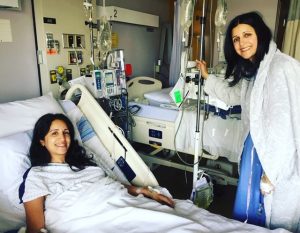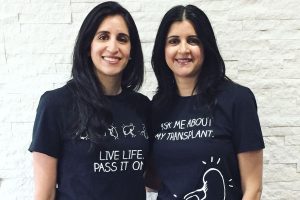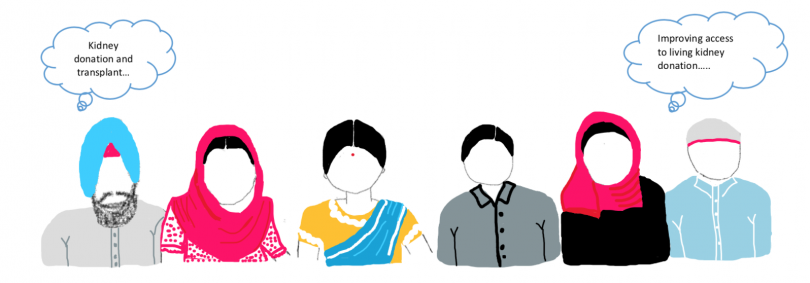Reema Garcha never hesitated when she knew her older sister Binn Johal would eventually need a kidney transplant. She was confident she would be a match, telling her sister, “Don’t worry, we’ve got this.” And on February 26, 2018 at St. Paul’s Hospital, after Johal had suffered from kidney failure for two decades, Garcha gave her a kidney.

Reema Garcha donated a kidney to her sister Binn Johal on February 26, 2018.
“Even three years later, I always get goosebumps,” says Garcha. “I still can’t believe science makes it possible to take out my organ and have it continue to function and thrive in my sister. It’s remarkable, and the best thing that could have ever happened to me in my life.”
The sisters had enthusiastic support from their family and friends as they underwent their journey with living kidney donation and transplant, but their experience is not always the case within the South Asian community.
Kidney disease higher in South Asians while living donation rates lower
“We have learned a lot about cultural differences in decision-making and how this may impact one’s willingness to consider donation or transplantation,” explains Dr. Jag Gill, Scientist with the Centre for Health Evaluation and Outcome Sciences (CHÉOS) and the Medical Director of the Kidney Transplant Program at St. Paul’s. He is leading the ACTION study to address inequities in access to living donation kidney transplant (LDKT) in South Asian communities in BC. Dr. Gill’s counterparts at UHN in Toronto are researching the experiences of African, Caribbean and Black (ACB) communities in Ontario as part of the same study.
Access to LDKT is dramatically reduced among ethno-racial minority groups in Canada. Some studies report a 50 to 70 per cent lower likelihood of transplantation in South Asian, East Asian, Indigenous and ACB populations compared to Caucasians. At the same time, the prevalence of end-stage kidney disease is higher in those populations.

CHÉOS Scientist Dr. Jag Gill speaks at an organ donation event in 2019.
Dr. Gill says the work they have done so far points to many different reasons for the disparity in LDKT access. One of the primary issues is the lack of culturally appropriate information. “Linguistic barriers and culturally generic communication strategies remain a dominant barrier in the South Asian community while strong concerns regarding systemic bias in the health care system has been highlighted as a significant barrier for the ACB community.”
Asking for help can be difficult
Garcha is one of the ACTION project’s patient partners. She says it is disheartening to see the lower numbers of living kidney donors within her community, especially because the idea of selfless service and giving back is one of the founding principles of their Sikh religious beliefs.
Now 43 years old, the Langley resident had already had two children by the time she was a kidney donor. She thinks for younger women, that could be a factor in willingness to donate. She also points out how difficult it can be to ask for help, citing the story of a family friend who was on dialysis for years. “She didn’t have any family members that came forward as potential living donors. In fact, when we asked her about it, she said she didn’t want to ask anyone. It was almost this noble thing that she didn’t want to put this burden on her family.”
Culturally improving living kidney donation information
The ACTION study team, coordinated by Project Manager Jamey Shick, has just concluded a series of virtual community focus groups to better understand community perspectives on LDKT. Project Coordinator Reetinder Kaur actively engaged with community partners and cultural organizations to help form the groups, trying to make them as diverse as possible with geography, language, religion, gender and age taken into consideration. Now the team is taking that focus group data and previous interview data collected from donors and recipients and evaluating and revising clinical education materials and clinical pathways to culturally tailor them to address barriers to donation and transplantation.
This project is of great personal interest to Kaur and Qualitative Research Lead Phuc Dang. Kaur grew up in South Asia and is keen to gain a better understanding of the intersection of health and culture. Dang has witnessed firsthand the inequities that exist in health care while accompanying her mother to medical appointments as a supporter and translator.

The sisters are now advocates for organ donation and transplant.
“We are all motivated by the singular goal to ensure the best possible care to patients with kidney disease in BC and across Canada,” emphasizes Dr. Gill. “Ensuring equitable access to the gold standard therapy of living donor kidney transplantation is essential in meeting this goal.”
And Garcha and Johal are the perfect living example of this. Three years later, both are healthy and thriving. Johal’s energy levels are back and she has a whole new outlook on her future. “It’s just nice to know that my sister has a piece of me in her that is making her well,” smiles Garcha.
She hopes by participating in research and sharing their story, others will be inspired. “The act of being able to save someone’s life is indescribable. I don’t know what else could top this. This really is the ultimate gift on all sides, and it’s fabulous.”
This story was originally published on the CHEOS website.





